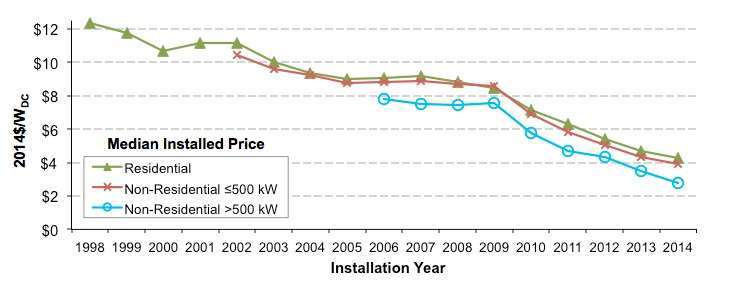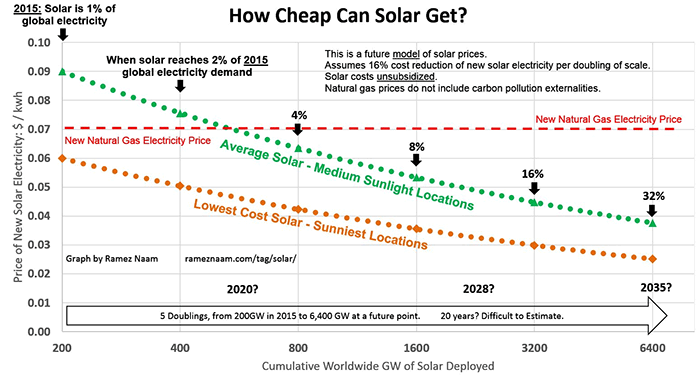How much cheaper solar energy

The cost of installed distributed photovoltaic systems, per watt.
The cost of solar panels in the US has been rapidly declining for more than 15 years. Experts ask themselves: how long will such a decline in prices continue and to what level will it reach? Can Moore's law apply to photovoltaic systems (PV)? The Tracking the Sun report by Lawrence Berkeley National Laboratory on price analysis of solar panels in the USA is dedicated to this topic .
The cost of small photovoltaic systems (less than 500 kW) for non-residential premises in 2014 decreased by $ 0.40 per watt, while the cost of more powerful systems from 500 kW decreased by $ 0.70 per watt. Thus, for the fifth year in a row, there has been a significant decrease in prices for solar panels with installation. And the process continues: in the first half of this year, prices fell another $ 0.20-0.50 / W, that is, 6-13%.
The constant decline in prices for photovoltaic systems is especially noteworthy against the background of a relatively stable price for the PV modules themselves. It has not changed much since 2012, the authors of the report note. In the US market, the price of panels falls due to lower associated installation costs, lower prices for other components (inverter, glass, aluminum, wires, etc.), more efficient system design, the cost of obtaining permits and inspections, cheaper labor of workers, and also thanks to the efforts marketing and market capture companies.
As a result, the cost of “solar electricity”, which is generated at commercial solar power plants, is seriously reduced. The following graph shows the value of contracts signed with the operators of such power plants from 2007 to 2015. The diameter of the circle corresponds to the power output of the power plant. The red color indicates the contracts for which the supply of electricity to the network has not yet begun.

As you can see, over the past 7-8 years, the cost has fallen from $ 200 per MWh (i.e. 20 cents per kWh) to almost $ 40 per MWh (4 cents per kWh). Figures taken from Lawrence Berkeley National Laboratory report “ Is $ 50 / MWh Solar for Real? ”
A particularly clear drop in prices can be seen if the dependence is not shown in time, but in the total capacity of already installed panels, that is, power plants commissioned. Here you can see that the price drop is very stable: for every doubling of the total capacity, the installation price of new panels is reduced by 16%.

This is a completely natural effect: prices for any product should decrease with an increase in sales.
Analysts are paying attention to the wide range of prices in the USA. So, 20% of the cheapest PV-systems for residential buildings were installed at a price of less than $ 3.50 / W, and 20% of the most expensive - at a price higher than $ 5.30 / W. The difference in price is explained by a number of factors: system design, selection of components, market conditions, features of regional regulation, etc.
The “Tracking the Sun” report is based on information collected from over 400,000 photovoltaic systems installed in residential and non-residential buildings from 1998 to 2014 in 42 states. This is more than 80% of all PV systems installed in the country for a given period.
To what level will solar energy prices fall? If the “Moore’s Law” here remains valid, then by 2020 or 2021 the total capacity of all solar power plants in the world will reach 600 GW, and the cost of electricity without subsidies will drop to 4.5 cents per kWh for the sunniest areas (southern USA, Australia, The Middle East, etc.) and up to 6.5 cents per kWh for moderately sunny areas (Central Europe, most of the United States).

And this is not the limit, adherents of solar energy say. When generation volumes double four more times, solar energy will provide 16% of the world's energy needs. In this case, the cost will drop to 3-4.5 cents per kWh. This is more than two times cheaper than the cost of electricity from coal or natural gas power plants. Analysts of the International Energy Agency , as well as experts from the Fraunhofer Institute for Solar Energy Systems, agree
with this prediction .
